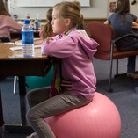This is an archived article that was published on sltrib.com in 2010, and information in the article may be outdated. It is provided only for personal research purposes and may not be reprinted.
Bountiful • Since the beginning of time, adults have pleaded with kids to just sit still.
But some, such as fourth-grade teacher Meredith Dyer, are trying a new tactic. In Dyer's Adelaide Elementary classroom, about one-third of the students sit on large, colorful fitness balls instead of chairs. The kids rock, roll and bounce slightly during lessons, and Dyer says it seems to actually help some of them focus.
"The ones that have a hard time paying attention, that have a hard time focusing and staying on task, it hasn't cured it, but I think it's helped," said Dyer, who first started letting kids use the balls about three years ago. "I wouldn't want to sit on those hard chairs all day."
Dyer's not the only teacher who has traded small, stiff chairs for bright, bouncy balls. At least hundreds of other teachers nationwide have also made the switch, saying it helps their kids shake off excess energy, focus and improve their posture.
At least one company in Wisconsin specializes in selling the balls to schools. Lisa Witt, owner of the Wisconsin-based WittFitt, said she has probably sold the balls to teachers in about 500 or 600 schools nationwide, including in Utah.
Witt, a former teacher, started using the balls in her own classroom about a decade ago to help students become more physically active. After having success, Witt started WittFitt to sell the balls, with lessons and guides to help teachers use them. The lessons include information about posture and health, and rules to help teachers make sure the kids take care of the balls and don't see them as toys.
For example, Witt recommends teachers ask their students to sign contracts agreeing to the rules and recommends they take away the balls for two weeks if the rules are broken.
"Some people who are skeptical are thinking, 'Are you kidding? You're going to have 25 kids bouncing on balls?' That's not what we promote. It's really a subtle rocking and bouncing," Witt said. "Generally kids will bounce and shift subtly, but that's what gets their blood flowing and keeps their energy and attention up."
All the third-graders in Leslie Stilson's class at Spring Creek Elementary in Provo sit on blue and green WittFitt balls. Stilson said in the two years she has employed the balls in her classroom, she has seen behavior improve.
"If my students need to move, instead of standing up or running around the classroom, they can actually bounce on these stability balls and they can move in every direction," Stilson said. "They can be busy in their own little realm. They don't have to be busy with their neighbor."
Karen Jacobs, with the International Ergonomics Association, said she has not seen evidence-based, peer-reviewed research on the balls in classrooms, but that generally adults and children should change their posture every 20 to 30 minutes. She said sitting or standing in one position for too long isn't good for anyone.
"The most important thing, if you're looking at children and ergonomics, is you want to help the child work in comfort and change and vary their postures often, no matter where they are, whether they're at a school desk or at home," said Jacobs, who is also a professor of occupational therapy at Boston University. "A child will probably be at their optimal readiness to learn if they're in a comfortable posture."
She said more research is needed over time to know if the balls really make a difference.
Comfort is the main reason many of Dyer's students say they like the balls.
"Chairs are hard; these are kind of soft," said fourth-grader Shuying Ma.
"It's more comfortable," added classmate Lily Moscon, who sits on a pink one.
Dyer doesn't require her students to use the balls and she isn't a WittFitt customer. Instead, she got the idea to use the balls while working as a nanny one summer. She said her employer sat on one of the balls at home as a way to work her core muscles. Dyer decided to try it in her classroom to help her students feel more comfortable.
Dyer said she leaves it up to parents whether they want to buy the balls for their kids.
Parent Laurie Mudrow, whose daughter Mikayla is in Dyer's class, said she bought a clear ball for her daughter at Walmart for less than $10. She was skeptical, but she has noticed her daughter seems to sit up straighter now.
"I thought for sure it would be a distraction, but … I don't think it's a distraction," Mudrow said. "When I've been in the room they don't seem to bounce on them. They just seem to sit on them. Sitting on a hard chair all day, I think, is hard for those kids."
Usually the kids bounce a lot during the first week of school, Dyer said, but eventually the novelty wears off and they sit calmly. At the end of the day, when students put their chairs upside down on top of their desks, they put the balls on top of the chairs to keep them from rolling.
Fourth-grader Jessica Marttila, who sits on a green ball, said she was eager to try a ball ever since she walked past Dyer's classroom a couple of years ago.
"I was looking forward to it since second grade," Jessica said.
Round chairs help kids with ADHD, autism?
One study published in the American Journal of Occupational Therapy in 2003 found the balls could help kids with Attention Deficit Hyperactivity Disorder (ADHD) stay seated and write more clearly. Another study published in The Journal of Autism and Developmental Disorders in 2004 found the balls might also help young children with autism stay in their seats and better engage their surroundings.





